The Contrast Between Management and Leadership
VerifiedAdded on 2023/01/12
|6
|2560
|53
AI Summary
This report discusses the contrast between leadership and management, their characteristics, functions, and differences. It highlights the importance of both in achieving organizational goals and objectives.
Contribute Materials
Your contribution can guide someone’s learning journey. Share your
documents today.
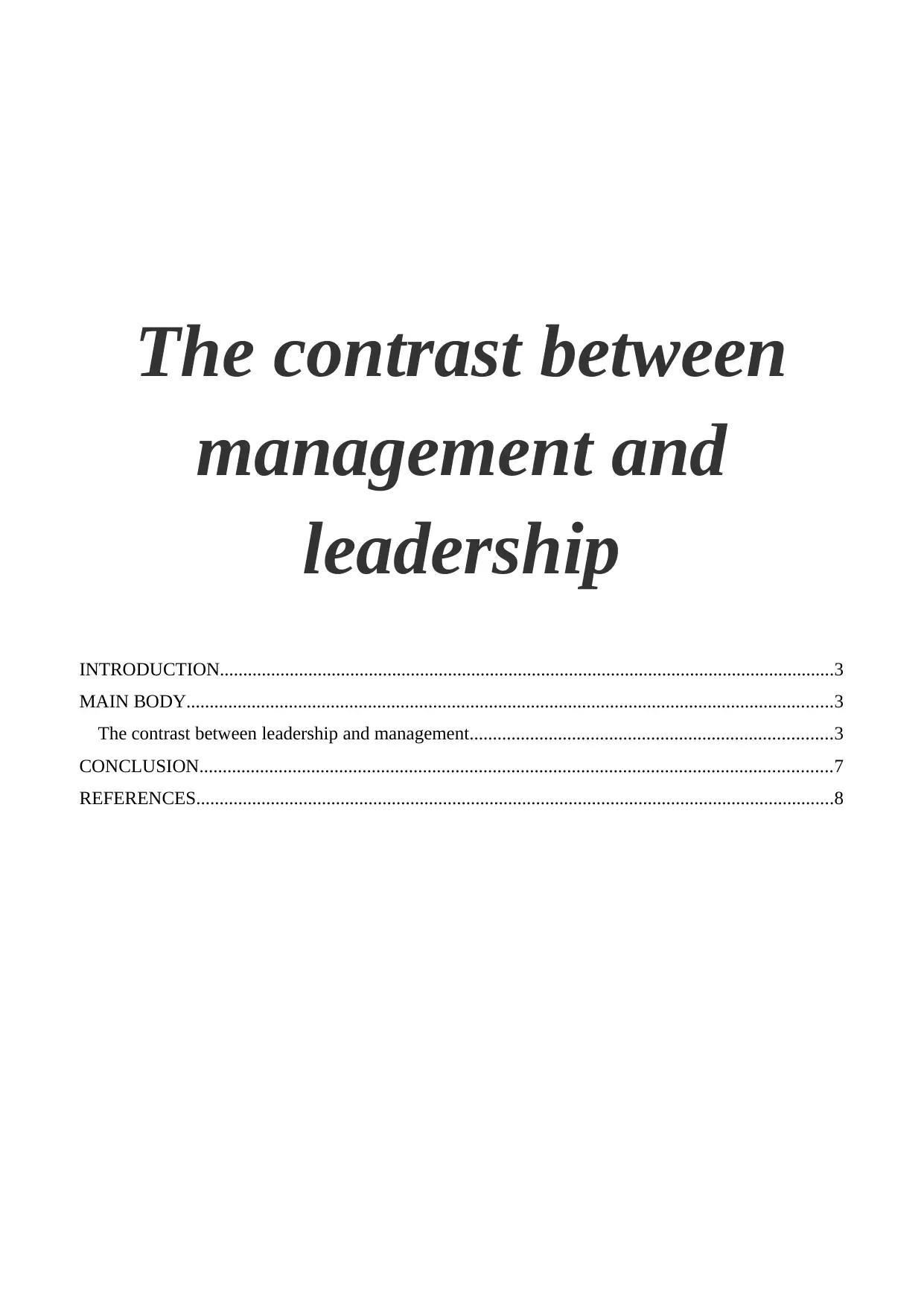
The contrast between
management and
leadership
INTRODUCTION....................................................................................................................................3
MAIN BODY...........................................................................................................................................3
The contrast between leadership and management..............................................................................3
CONCLUSION........................................................................................................................................7
REFERENCES.........................................................................................................................................8
management and
leadership
INTRODUCTION....................................................................................................................................3
MAIN BODY...........................................................................................................................................3
The contrast between leadership and management..............................................................................3
CONCLUSION........................................................................................................................................7
REFERENCES.........................................................................................................................................8
Secure Best Marks with AI Grader
Need help grading? Try our AI Grader for instant feedback on your assignments.
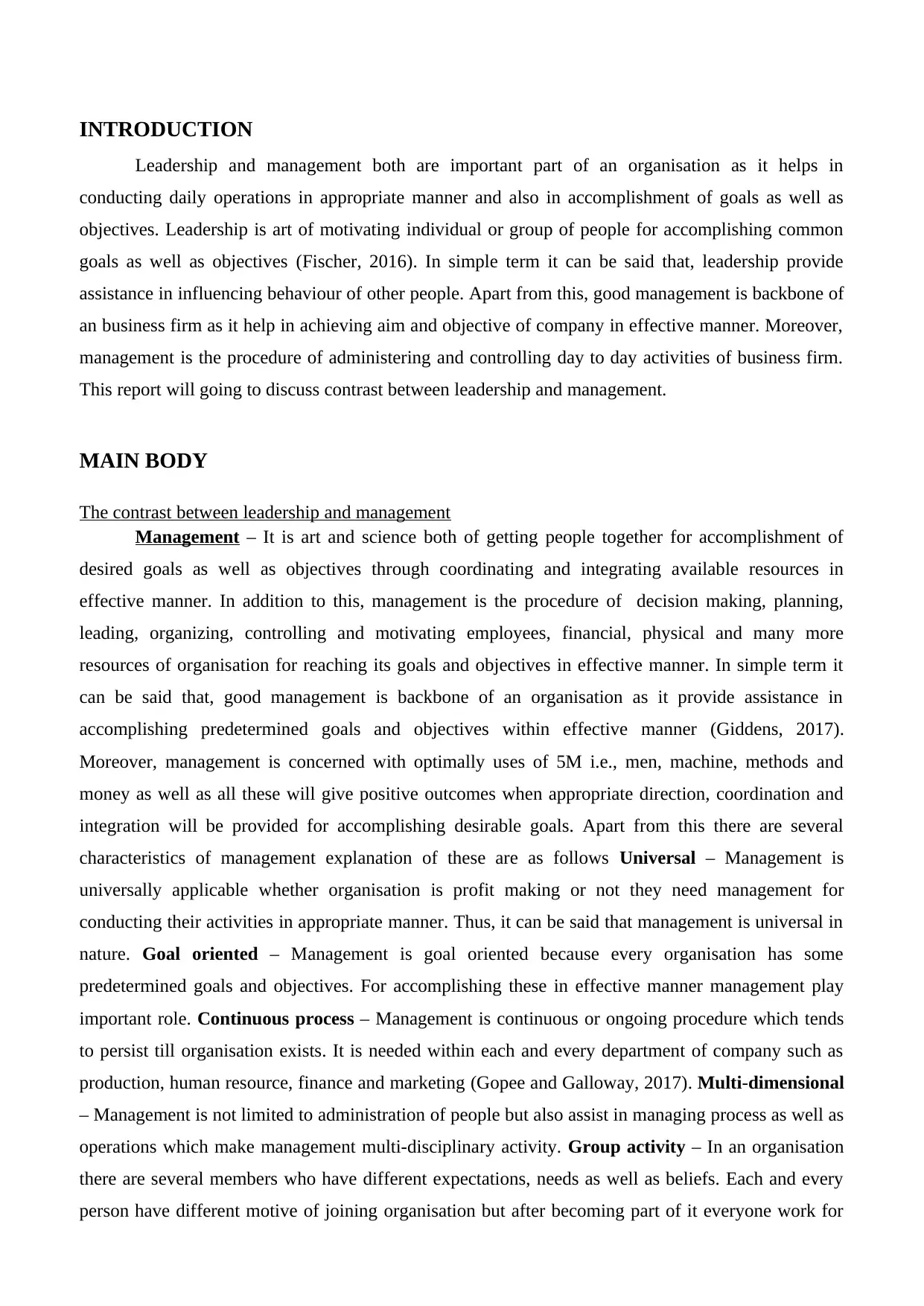
INTRODUCTION
Leadership and management both are important part of an organisation as it helps in
conducting daily operations in appropriate manner and also in accomplishment of goals as well as
objectives. Leadership is art of motivating individual or group of people for accomplishing common
goals as well as objectives (Fischer, 2016). In simple term it can be said that, leadership provide
assistance in influencing behaviour of other people. Apart from this, good management is backbone of
an business firm as it help in achieving aim and objective of company in effective manner. Moreover,
management is the procedure of administering and controlling day to day activities of business firm.
This report will going to discuss contrast between leadership and management.
MAIN BODY
The contrast between leadership and management
Management – It is art and science both of getting people together for accomplishment of
desired goals as well as objectives through coordinating and integrating available resources in
effective manner. In addition to this, management is the procedure of decision making, planning,
leading, organizing, controlling and motivating employees, financial, physical and many more
resources of organisation for reaching its goals and objectives in effective manner. In simple term it
can be said that, good management is backbone of an organisation as it provide assistance in
accomplishing predetermined goals and objectives within effective manner (Giddens, 2017).
Moreover, management is concerned with optimally uses of 5M i.e., men, machine, methods and
money as well as all these will give positive outcomes when appropriate direction, coordination and
integration will be provided for accomplishing desirable goals. Apart from this there are several
characteristics of management explanation of these are as follows Universal – Management is
universally applicable whether organisation is profit making or not they need management for
conducting their activities in appropriate manner. Thus, it can be said that management is universal in
nature. Goal oriented – Management is goal oriented because every organisation has some
predetermined goals and objectives. For accomplishing these in effective manner management play
important role. Continuous process – Management is continuous or ongoing procedure which tends
to persist till organisation exists. It is needed within each and every department of company such as
production, human resource, finance and marketing (Gopee and Galloway, 2017). Multi-dimensional
– Management is not limited to administration of people but also assist in managing process as well as
operations which make management multi-disciplinary activity. Group activity – In an organisation
there are several members who have different expectations, needs as well as beliefs. Each and every
person have different motive of joining organisation but after becoming part of it everyone work for
Leadership and management both are important part of an organisation as it helps in
conducting daily operations in appropriate manner and also in accomplishment of goals as well as
objectives. Leadership is art of motivating individual or group of people for accomplishing common
goals as well as objectives (Fischer, 2016). In simple term it can be said that, leadership provide
assistance in influencing behaviour of other people. Apart from this, good management is backbone of
an business firm as it help in achieving aim and objective of company in effective manner. Moreover,
management is the procedure of administering and controlling day to day activities of business firm.
This report will going to discuss contrast between leadership and management.
MAIN BODY
The contrast between leadership and management
Management – It is art and science both of getting people together for accomplishment of
desired goals as well as objectives through coordinating and integrating available resources in
effective manner. In addition to this, management is the procedure of decision making, planning,
leading, organizing, controlling and motivating employees, financial, physical and many more
resources of organisation for reaching its goals and objectives in effective manner. In simple term it
can be said that, good management is backbone of an organisation as it provide assistance in
accomplishing predetermined goals and objectives within effective manner (Giddens, 2017).
Moreover, management is concerned with optimally uses of 5M i.e., men, machine, methods and
money as well as all these will give positive outcomes when appropriate direction, coordination and
integration will be provided for accomplishing desirable goals. Apart from this there are several
characteristics of management explanation of these are as follows Universal – Management is
universally applicable whether organisation is profit making or not they need management for
conducting their activities in appropriate manner. Thus, it can be said that management is universal in
nature. Goal oriented – Management is goal oriented because every organisation has some
predetermined goals and objectives. For accomplishing these in effective manner management play
important role. Continuous process – Management is continuous or ongoing procedure which tends
to persist till organisation exists. It is needed within each and every department of company such as
production, human resource, finance and marketing (Gopee and Galloway, 2017). Multi-dimensional
– Management is not limited to administration of people but also assist in managing process as well as
operations which make management multi-disciplinary activity. Group activity – In an organisation
there are several members who have different expectations, needs as well as beliefs. Each and every
person have different motive of joining organisation but after becoming part of it everyone work for
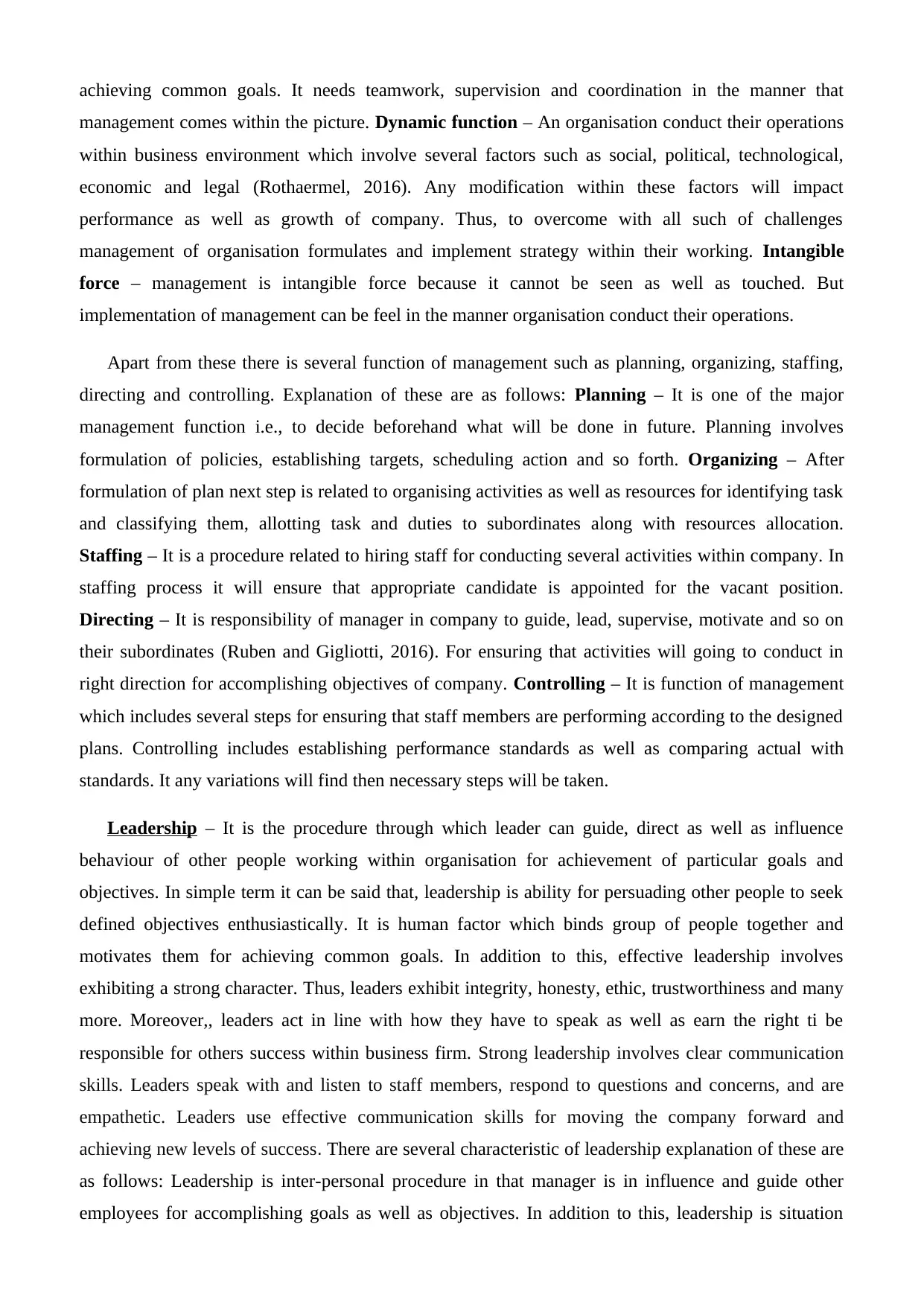
achieving common goals. It needs teamwork, supervision and coordination in the manner that
management comes within the picture. Dynamic function – An organisation conduct their operations
within business environment which involve several factors such as social, political, technological,
economic and legal (Rothaermel, 2016). Any modification within these factors will impact
performance as well as growth of company. Thus, to overcome with all such of challenges
management of organisation formulates and implement strategy within their working. Intangible
force – management is intangible force because it cannot be seen as well as touched. But
implementation of management can be feel in the manner organisation conduct their operations.
Apart from these there is several function of management such as planning, organizing, staffing,
directing and controlling. Explanation of these are as follows: Planning – It is one of the major
management function i.e., to decide beforehand what will be done in future. Planning involves
formulation of policies, establishing targets, scheduling action and so forth. Organizing – After
formulation of plan next step is related to organising activities as well as resources for identifying task
and classifying them, allotting task and duties to subordinates along with resources allocation.
Staffing – It is a procedure related to hiring staff for conducting several activities within company. In
staffing process it will ensure that appropriate candidate is appointed for the vacant position.
Directing – It is responsibility of manager in company to guide, lead, supervise, motivate and so on
their subordinates (Ruben and Gigliotti, 2016). For ensuring that activities will going to conduct in
right direction for accomplishing objectives of company. Controlling – It is function of management
which includes several steps for ensuring that staff members are performing according to the designed
plans. Controlling includes establishing performance standards as well as comparing actual with
standards. It any variations will find then necessary steps will be taken.
Leadership – It is the procedure through which leader can guide, direct as well as influence
behaviour of other people working within organisation for achievement of particular goals and
objectives. In simple term it can be said that, leadership is ability for persuading other people to seek
defined objectives enthusiastically. It is human factor which binds group of people together and
motivates them for achieving common goals. In addition to this, effective leadership involves
exhibiting a strong character. Thus, leaders exhibit integrity, honesty, ethic, trustworthiness and many
more. Moreover,, leaders act in line with how they have to speak as well as earn the right ti be
responsible for others success within business firm. Strong leadership involves clear communication
skills. Leaders speak with and listen to staff members, respond to questions and concerns, and are
empathetic. Leaders use effective communication skills for moving the company forward and
achieving new levels of success. There are several characteristic of leadership explanation of these are
as follows: Leadership is inter-personal procedure in that manager is in influence and guide other
employees for accomplishing goals as well as objectives. In addition to this, leadership is situation
management comes within the picture. Dynamic function – An organisation conduct their operations
within business environment which involve several factors such as social, political, technological,
economic and legal (Rothaermel, 2016). Any modification within these factors will impact
performance as well as growth of company. Thus, to overcome with all such of challenges
management of organisation formulates and implement strategy within their working. Intangible
force – management is intangible force because it cannot be seen as well as touched. But
implementation of management can be feel in the manner organisation conduct their operations.
Apart from these there is several function of management such as planning, organizing, staffing,
directing and controlling. Explanation of these are as follows: Planning – It is one of the major
management function i.e., to decide beforehand what will be done in future. Planning involves
formulation of policies, establishing targets, scheduling action and so forth. Organizing – After
formulation of plan next step is related to organising activities as well as resources for identifying task
and classifying them, allotting task and duties to subordinates along with resources allocation.
Staffing – It is a procedure related to hiring staff for conducting several activities within company. In
staffing process it will ensure that appropriate candidate is appointed for the vacant position.
Directing – It is responsibility of manager in company to guide, lead, supervise, motivate and so on
their subordinates (Ruben and Gigliotti, 2016). For ensuring that activities will going to conduct in
right direction for accomplishing objectives of company. Controlling – It is function of management
which includes several steps for ensuring that staff members are performing according to the designed
plans. Controlling includes establishing performance standards as well as comparing actual with
standards. It any variations will find then necessary steps will be taken.
Leadership – It is the procedure through which leader can guide, direct as well as influence
behaviour of other people working within organisation for achievement of particular goals and
objectives. In simple term it can be said that, leadership is ability for persuading other people to seek
defined objectives enthusiastically. It is human factor which binds group of people together and
motivates them for achieving common goals. In addition to this, effective leadership involves
exhibiting a strong character. Thus, leaders exhibit integrity, honesty, ethic, trustworthiness and many
more. Moreover,, leaders act in line with how they have to speak as well as earn the right ti be
responsible for others success within business firm. Strong leadership involves clear communication
skills. Leaders speak with and listen to staff members, respond to questions and concerns, and are
empathetic. Leaders use effective communication skills for moving the company forward and
achieving new levels of success. There are several characteristic of leadership explanation of these are
as follows: Leadership is inter-personal procedure in that manager is in influence and guide other
employees for accomplishing goals as well as objectives. In addition to this, leadership is situation
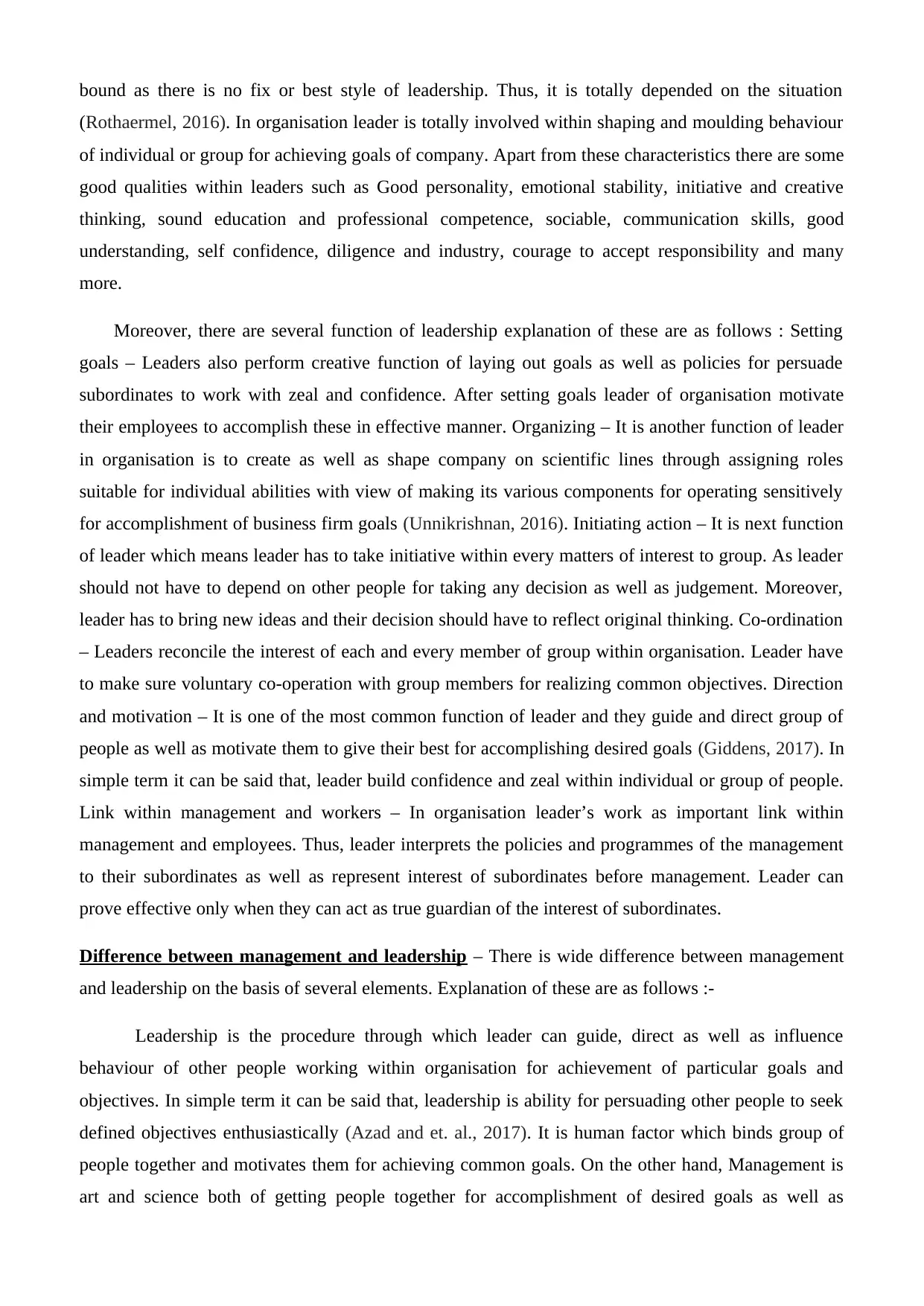
bound as there is no fix or best style of leadership. Thus, it is totally depended on the situation
(Rothaermel, 2016). In organisation leader is totally involved within shaping and moulding behaviour
of individual or group for achieving goals of company. Apart from these characteristics there are some
good qualities within leaders such as Good personality, emotional stability, initiative and creative
thinking, sound education and professional competence, sociable, communication skills, good
understanding, self confidence, diligence and industry, courage to accept responsibility and many
more.
Moreover, there are several function of leadership explanation of these are as follows : Setting
goals – Leaders also perform creative function of laying out goals as well as policies for persuade
subordinates to work with zeal and confidence. After setting goals leader of organisation motivate
their employees to accomplish these in effective manner. Organizing – It is another function of leader
in organisation is to create as well as shape company on scientific lines through assigning roles
suitable for individual abilities with view of making its various components for operating sensitively
for accomplishment of business firm goals (Unnikrishnan, 2016). Initiating action – It is next function
of leader which means leader has to take initiative within every matters of interest to group. As leader
should not have to depend on other people for taking any decision as well as judgement. Moreover,
leader has to bring new ideas and their decision should have to reflect original thinking. Co-ordination
– Leaders reconcile the interest of each and every member of group within organisation. Leader have
to make sure voluntary co-operation with group members for realizing common objectives. Direction
and motivation – It is one of the most common function of leader and they guide and direct group of
people as well as motivate them to give their best for accomplishing desired goals (Giddens, 2017). In
simple term it can be said that, leader build confidence and zeal within individual or group of people.
Link within management and workers – In organisation leader’s work as important link within
management and employees. Thus, leader interprets the policies and programmes of the management
to their subordinates as well as represent interest of subordinates before management. Leader can
prove effective only when they can act as true guardian of the interest of subordinates.
Difference between management and leadership – There is wide difference between management
and leadership on the basis of several elements. Explanation of these are as follows :-
Leadership is the procedure through which leader can guide, direct as well as influence
behaviour of other people working within organisation for achievement of particular goals and
objectives. In simple term it can be said that, leadership is ability for persuading other people to seek
defined objectives enthusiastically (Azad and et. al., 2017). It is human factor which binds group of
people together and motivates them for achieving common goals. On the other hand, Management is
art and science both of getting people together for accomplishment of desired goals as well as
(Rothaermel, 2016). In organisation leader is totally involved within shaping and moulding behaviour
of individual or group for achieving goals of company. Apart from these characteristics there are some
good qualities within leaders such as Good personality, emotional stability, initiative and creative
thinking, sound education and professional competence, sociable, communication skills, good
understanding, self confidence, diligence and industry, courage to accept responsibility and many
more.
Moreover, there are several function of leadership explanation of these are as follows : Setting
goals – Leaders also perform creative function of laying out goals as well as policies for persuade
subordinates to work with zeal and confidence. After setting goals leader of organisation motivate
their employees to accomplish these in effective manner. Organizing – It is another function of leader
in organisation is to create as well as shape company on scientific lines through assigning roles
suitable for individual abilities with view of making its various components for operating sensitively
for accomplishment of business firm goals (Unnikrishnan, 2016). Initiating action – It is next function
of leader which means leader has to take initiative within every matters of interest to group. As leader
should not have to depend on other people for taking any decision as well as judgement. Moreover,
leader has to bring new ideas and their decision should have to reflect original thinking. Co-ordination
– Leaders reconcile the interest of each and every member of group within organisation. Leader have
to make sure voluntary co-operation with group members for realizing common objectives. Direction
and motivation – It is one of the most common function of leader and they guide and direct group of
people as well as motivate them to give their best for accomplishing desired goals (Giddens, 2017). In
simple term it can be said that, leader build confidence and zeal within individual or group of people.
Link within management and workers – In organisation leader’s work as important link within
management and employees. Thus, leader interprets the policies and programmes of the management
to their subordinates as well as represent interest of subordinates before management. Leader can
prove effective only when they can act as true guardian of the interest of subordinates.
Difference between management and leadership – There is wide difference between management
and leadership on the basis of several elements. Explanation of these are as follows :-
Leadership is the procedure through which leader can guide, direct as well as influence
behaviour of other people working within organisation for achievement of particular goals and
objectives. In simple term it can be said that, leadership is ability for persuading other people to seek
defined objectives enthusiastically (Azad and et. al., 2017). It is human factor which binds group of
people together and motivates them for achieving common goals. On the other hand, Management is
art and science both of getting people together for accomplishment of desired goals as well as
Secure Best Marks with AI Grader
Need help grading? Try our AI Grader for instant feedback on your assignments.
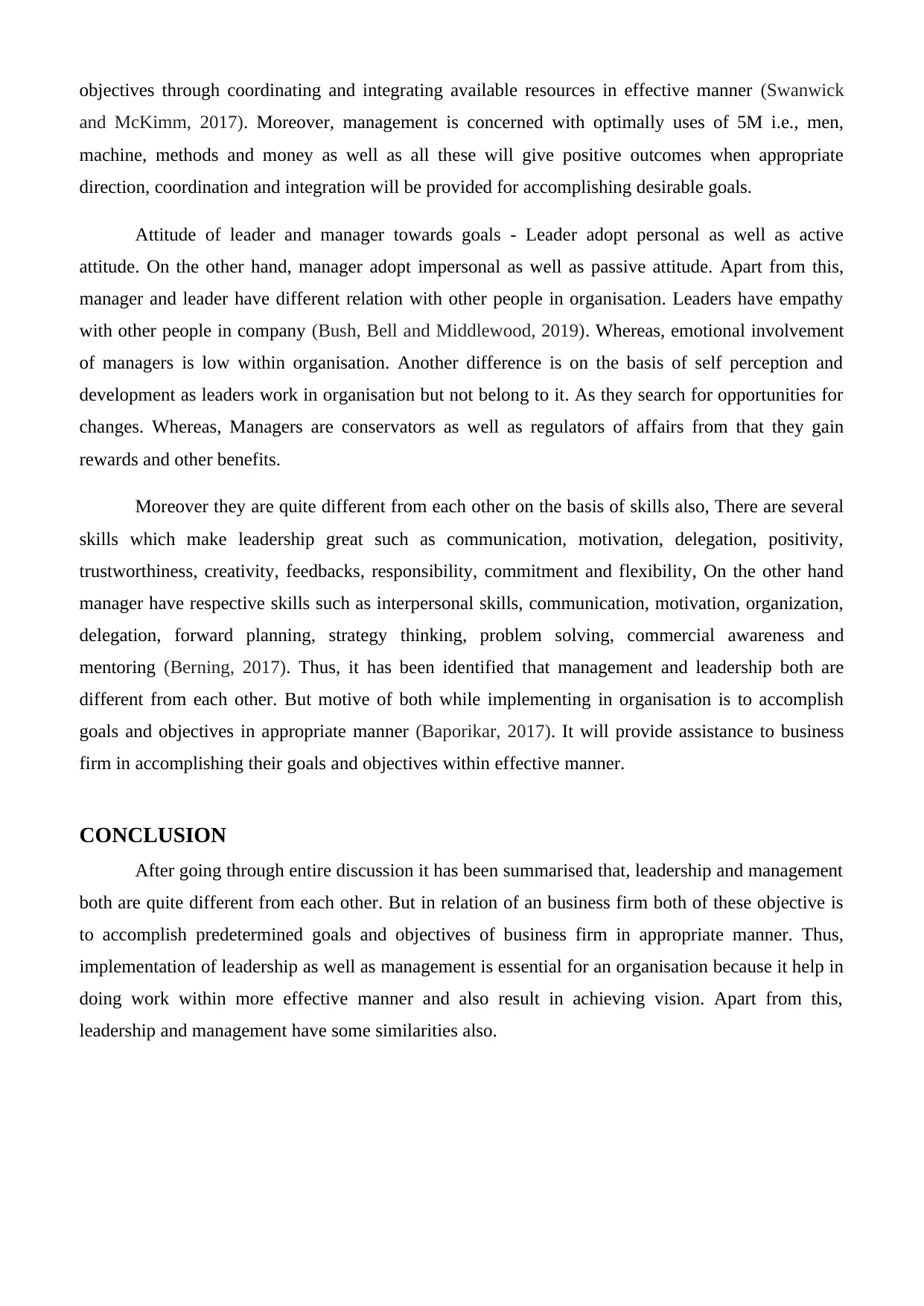
objectives through coordinating and integrating available resources in effective manner (Swanwick
and McKimm, 2017). Moreover, management is concerned with optimally uses of 5M i.e., men,
machine, methods and money as well as all these will give positive outcomes when appropriate
direction, coordination and integration will be provided for accomplishing desirable goals.
Attitude of leader and manager towards goals - Leader adopt personal as well as active
attitude. On the other hand, manager adopt impersonal as well as passive attitude. Apart from this,
manager and leader have different relation with other people in organisation. Leaders have empathy
with other people in company (Bush, Bell and Middlewood, 2019). Whereas, emotional involvement
of managers is low within organisation. Another difference is on the basis of self perception and
development as leaders work in organisation but not belong to it. As they search for opportunities for
changes. Whereas, Managers are conservators as well as regulators of affairs from that they gain
rewards and other benefits.
Moreover they are quite different from each other on the basis of skills also, There are several
skills which make leadership great such as communication, motivation, delegation, positivity,
trustworthiness, creativity, feedbacks, responsibility, commitment and flexibility, On the other hand
manager have respective skills such as interpersonal skills, communication, motivation, organization,
delegation, forward planning, strategy thinking, problem solving, commercial awareness and
mentoring (Berning, 2017). Thus, it has been identified that management and leadership both are
different from each other. But motive of both while implementing in organisation is to accomplish
goals and objectives in appropriate manner (Baporikar, 2017). It will provide assistance to business
firm in accomplishing their goals and objectives within effective manner.
CONCLUSION
After going through entire discussion it has been summarised that, leadership and management
both are quite different from each other. But in relation of an business firm both of these objective is
to accomplish predetermined goals and objectives of business firm in appropriate manner. Thus,
implementation of leadership as well as management is essential for an organisation because it help in
doing work within more effective manner and also result in achieving vision. Apart from this,
leadership and management have some similarities also.
and McKimm, 2017). Moreover, management is concerned with optimally uses of 5M i.e., men,
machine, methods and money as well as all these will give positive outcomes when appropriate
direction, coordination and integration will be provided for accomplishing desirable goals.
Attitude of leader and manager towards goals - Leader adopt personal as well as active
attitude. On the other hand, manager adopt impersonal as well as passive attitude. Apart from this,
manager and leader have different relation with other people in organisation. Leaders have empathy
with other people in company (Bush, Bell and Middlewood, 2019). Whereas, emotional involvement
of managers is low within organisation. Another difference is on the basis of self perception and
development as leaders work in organisation but not belong to it. As they search for opportunities for
changes. Whereas, Managers are conservators as well as regulators of affairs from that they gain
rewards and other benefits.
Moreover they are quite different from each other on the basis of skills also, There are several
skills which make leadership great such as communication, motivation, delegation, positivity,
trustworthiness, creativity, feedbacks, responsibility, commitment and flexibility, On the other hand
manager have respective skills such as interpersonal skills, communication, motivation, organization,
delegation, forward planning, strategy thinking, problem solving, commercial awareness and
mentoring (Berning, 2017). Thus, it has been identified that management and leadership both are
different from each other. But motive of both while implementing in organisation is to accomplish
goals and objectives in appropriate manner (Baporikar, 2017). It will provide assistance to business
firm in accomplishing their goals and objectives within effective manner.
CONCLUSION
After going through entire discussion it has been summarised that, leadership and management
both are quite different from each other. But in relation of an business firm both of these objective is
to accomplish predetermined goals and objectives of business firm in appropriate manner. Thus,
implementation of leadership as well as management is essential for an organisation because it help in
doing work within more effective manner and also result in achieving vision. Apart from this,
leadership and management have some similarities also.
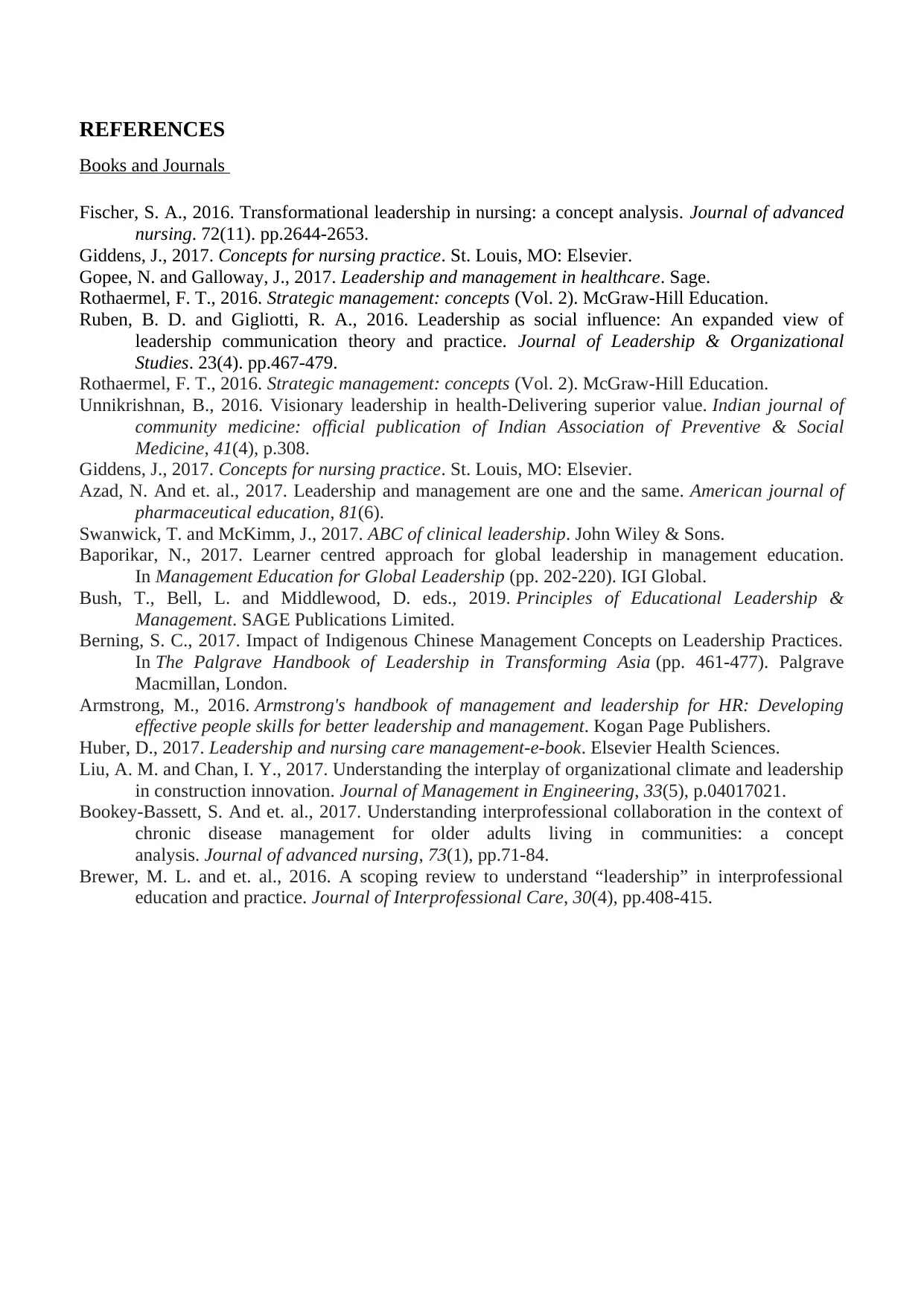
REFERENCES
Books and Journals
Fischer, S. A., 2016. Transformational leadership in nursing: a concept analysis. Journal of advanced
nursing. 72(11). pp.2644-2653.
Giddens, J., 2017. Concepts for nursing practice. St. Louis, MO: Elsevier.
Gopee, N. and Galloway, J., 2017. Leadership and management in healthcare. Sage.
Rothaermel, F. T., 2016. Strategic management: concepts (Vol. 2). McGraw-Hill Education.
Ruben, B. D. and Gigliotti, R. A., 2016. Leadership as social influence: An expanded view of
leadership communication theory and practice. Journal of Leadership & Organizational
Studies. 23(4). pp.467-479.
Rothaermel, F. T., 2016. Strategic management: concepts (Vol. 2). McGraw-Hill Education.
Unnikrishnan, B., 2016. Visionary leadership in health-Delivering superior value. Indian journal of
community medicine: official publication of Indian Association of Preventive & Social
Medicine, 41(4), p.308.
Giddens, J., 2017. Concepts for nursing practice. St. Louis, MO: Elsevier.
Azad, N. And et. al., 2017. Leadership and management are one and the same. American journal of
pharmaceutical education, 81(6).
Swanwick, T. and McKimm, J., 2017. ABC of clinical leadership. John Wiley & Sons.
Baporikar, N., 2017. Learner centred approach for global leadership in management education.
In Management Education for Global Leadership (pp. 202-220). IGI Global.
Bush, T., Bell, L. and Middlewood, D. eds., 2019. Principles of Educational Leadership &
Management. SAGE Publications Limited.
Berning, S. C., 2017. Impact of Indigenous Chinese Management Concepts on Leadership Practices.
In The Palgrave Handbook of Leadership in Transforming Asia (pp. 461-477). Palgrave
Macmillan, London.
Armstrong, M., 2016. Armstrong's handbook of management and leadership for HR: Developing
effective people skills for better leadership and management. Kogan Page Publishers.
Huber, D., 2017. Leadership and nursing care management-e-book. Elsevier Health Sciences.
Liu, A. M. and Chan, I. Y., 2017. Understanding the interplay of organizational climate and leadership
in construction innovation. Journal of Management in Engineering, 33(5), p.04017021.
Bookey‐Bassett, S. And et. al., 2017. Understanding interprofessional collaboration in the context of
chronic disease management for older adults living in communities: a concept
analysis. Journal of advanced nursing, 73(1), pp.71-84.
Brewer, M. L. and et. al., 2016. A scoping review to understand “leadership” in interprofessional
education and practice. Journal of Interprofessional Care, 30(4), pp.408-415.
Books and Journals
Fischer, S. A., 2016. Transformational leadership in nursing: a concept analysis. Journal of advanced
nursing. 72(11). pp.2644-2653.
Giddens, J., 2017. Concepts for nursing practice. St. Louis, MO: Elsevier.
Gopee, N. and Galloway, J., 2017. Leadership and management in healthcare. Sage.
Rothaermel, F. T., 2016. Strategic management: concepts (Vol. 2). McGraw-Hill Education.
Ruben, B. D. and Gigliotti, R. A., 2016. Leadership as social influence: An expanded view of
leadership communication theory and practice. Journal of Leadership & Organizational
Studies. 23(4). pp.467-479.
Rothaermel, F. T., 2016. Strategic management: concepts (Vol. 2). McGraw-Hill Education.
Unnikrishnan, B., 2016. Visionary leadership in health-Delivering superior value. Indian journal of
community medicine: official publication of Indian Association of Preventive & Social
Medicine, 41(4), p.308.
Giddens, J., 2017. Concepts for nursing practice. St. Louis, MO: Elsevier.
Azad, N. And et. al., 2017. Leadership and management are one and the same. American journal of
pharmaceutical education, 81(6).
Swanwick, T. and McKimm, J., 2017. ABC of clinical leadership. John Wiley & Sons.
Baporikar, N., 2017. Learner centred approach for global leadership in management education.
In Management Education for Global Leadership (pp. 202-220). IGI Global.
Bush, T., Bell, L. and Middlewood, D. eds., 2019. Principles of Educational Leadership &
Management. SAGE Publications Limited.
Berning, S. C., 2017. Impact of Indigenous Chinese Management Concepts on Leadership Practices.
In The Palgrave Handbook of Leadership in Transforming Asia (pp. 461-477). Palgrave
Macmillan, London.
Armstrong, M., 2016. Armstrong's handbook of management and leadership for HR: Developing
effective people skills for better leadership and management. Kogan Page Publishers.
Huber, D., 2017. Leadership and nursing care management-e-book. Elsevier Health Sciences.
Liu, A. M. and Chan, I. Y., 2017. Understanding the interplay of organizational climate and leadership
in construction innovation. Journal of Management in Engineering, 33(5), p.04017021.
Bookey‐Bassett, S. And et. al., 2017. Understanding interprofessional collaboration in the context of
chronic disease management for older adults living in communities: a concept
analysis. Journal of advanced nursing, 73(1), pp.71-84.
Brewer, M. L. and et. al., 2016. A scoping review to understand “leadership” in interprofessional
education and practice. Journal of Interprofessional Care, 30(4), pp.408-415.
1 out of 6
Related Documents
Your All-in-One AI-Powered Toolkit for Academic Success.
+13062052269
info@desklib.com
Available 24*7 on WhatsApp / Email
![[object Object]](/_next/static/media/star-bottom.7253800d.svg)
Unlock your academic potential
© 2024 | Zucol Services PVT LTD | All rights reserved.





